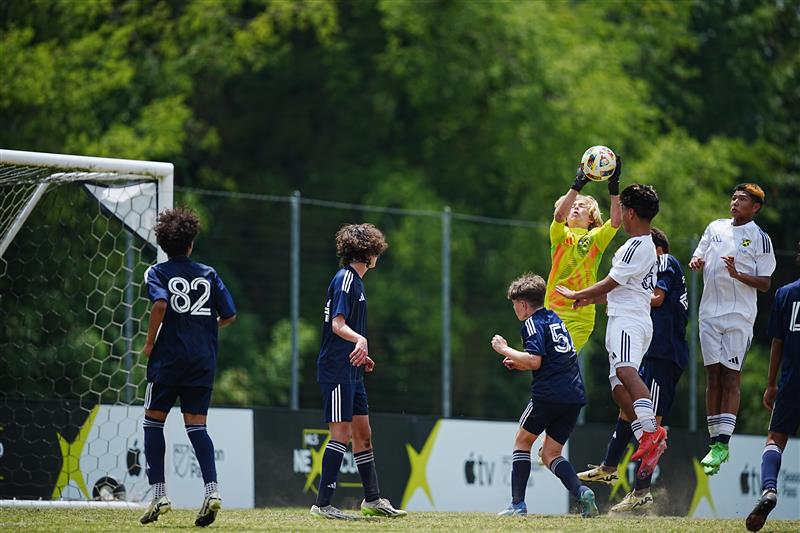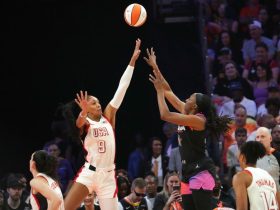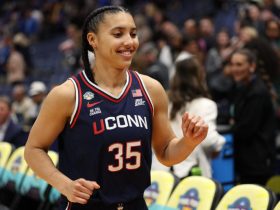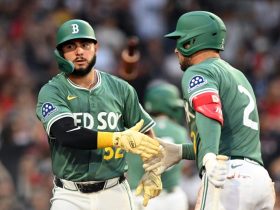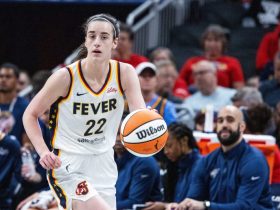Alfonso Mondelo was 13 years old when he arrived in the United States from Spain in 1971.
‘Soccer was almost nonexistent,’ he tells USA TODAY Sports. ‘You had to go chase it.’
Your desire to see the sport might take you to New York’s Felt Forum, the then-named auditorium at Madison Square Garden where Mondelo watched the 1974 World Cup on a closed-circuit television, or to movie theaters.
Even by 1990, Major League Soccer’s longtime technical director says, when the U.S. men qualified for the tournament in Italy, you went to a bar with a satellite dish to watch them.
‘If there was a baseball game, you had to fight with the baseball people to keep the soccer game on,’ Mondelo says. ‘So this has gone to where this is the country that consumes probably the most soccer in the world. Right now, you can turn on a TV on Saturday morning at 7 o’clock, begin to watch European games and continuously watch live soccer until probably 12:30, 1 o’clock in the morning, when MLS finishes.
‘It’s a sport that you can play forever. Every day, there are more American-born fans, and I would say under the age of 40 in this country, most players have played it at one level or the other.’
Mondelo, 66, spent time on the pitch in Spain’s second division while he was in the U.S. Air Force and later became a coach. He got his start as a coach in MLS with the New York/New Jersey MetroStars in the late 1990s. He moved to his position in the league’s front office in 2004, when teams had no youth programming.
Today, there are 40,000 kids participating in its MLS GO recreational program and almost 18,000 enrolled in its elite MLS NEXT platform (raising to 40,000-plus with a new competition tier), which runs from the U13 to U19 levels.
As of June 15, according to MLS, 93% of the players on U.S. youth national teams are coming from MLS NEXT. This year alone, the league also has invested more than $125 million in player development, according to Mondelo.
‘It’s the greatest sport in the world,’ says Mondelo, whom we interviewed upon the 30th anniversary of MLS. ‘Once you start playing it, you get hooked on it. If you speak soccer, you can engage conversations in any country in the world. I think the Americans are catching onto it. …
‘Now there is a direct pathway, so a young player who begins to play the game and has a passion for it can see a direct pathway from youth all the way to a professional team. Now, in a lot of the markets, they have a professional team that they can go see and they can aspire to be part of.’
The league realizes, of course, the overall percentages of becoming a professional player are very small. It’s constantly seeking ways to get more kids access to the game, hoping to create fans at the grassroots levels who will attend MLS matches.
Where might your son or daughter fit into MLS’ youth ecosystem? Here are the opportunities it provides:
MLS GO: Finding a lifelong love of the game
When we place our kid in a sport at a young age, a goal is they enjoy it and want to come back for another season.
‘We’re not trying to create world-class players from the time of 5 or 6 years old,’ says Kyle Albrecht, the general manager of MLS GO and MLS NEXT.
MLS GO is designed to teach fundamentals to boys and girls from 4 to 14 – sometimes playing in games together – in a community setting. It’s in 47 states and Washington D.C., and, if you’re in an MLS market, tickets to a pro game might be included with your entry fee.
Albrecht says the median age of an MLS GO player is 7 or 8 but it’s open to beginners throughout its age groups.
‘It also gives that opportunity at the higher end of the spectrum,’ Albrecht says. “Let’s say that individual player is not ready to go into the youth travel environment (with) more competitive aspects that we know have a tendency to drive kids and families out of the game.’
MLS GO, Albrecht says, was born in 2023 out of data that registered soccer participation wasn’t really growing over the past 20-plus years.
‘There was a real intentionality about the push to travel too early, (the) cost growing so high at young ages. How do we build a program to combat that negativity with the game becoming too intense for that recreational audience?’ Albrecht says.
MLS NEXT: Seeking your highest potential
Kids with more ambitious sports aspirations can try out for clubs within MLS NEXT starting at the U13 level. There are 29 MLS academies and 238 elite academies within the 267 clubs (including the second tier of competition) that make up MLS NEXT.
MLS NEXT academy teams compete in high-level events such as Generation Adidas Cup. The GA Cup began almost two decades ago as a gauge to evaluate how MLS academy teams were developing across the country and then started to bring in international competition.
‘When we first started there, it was hard to compete,’ Mondelo says. ‘The foreign teams were beating us; we got a draw, we felt that that was a positive result. And over the last 10, 15, years, we’re seeing that the MLS teams in some age groups are dominating the competition, so we are getting to be close to a world-level par in player development.
‘Also, the interest of international clubs on the players that are being developed domestically has risen tremendously. So they’ve seen the American player as a viable option to bring into top-level clubs worldwide.’
MLS NEXT came about in 2020, taking over when the U.S. Soccer Development Academy ended operations. There are 130 NEXT players who have matriculated to MLS. They include Diego Luna (Real Salt Lake), Benjamin Cremaschi (Inter Miami CF), Alex Freeman (Orlando City SC), Obed Vargas (Seattle Sounders FC) and Cavan Sullivan (Philadelphia Union).
MLS NEXT top-tier players agree to forgo participating simultaneously in both MLS NEXT and high school soccer, according to an MLS spokesperson, though clubs can submit a high school waiver and play. Players in the other tier will be allowed to play it.
‘Our objective from a player development strategy is to develop the next generation of talent that will affect the pro game, and the pro game includes Major League Soccer, it includes national teams,’ Luis Robles, MLS NEXT’s technical director, told USA TODAY Sports in January, when laying out the parameters of the second tier. ‘But within that object is another sub tier of, ‘How does that play itself out?’ We saw an opportunity to deepen the player pool, to give more families that experience. … So it is the aspirational athlete, but it’s also just the athlete that wants to continue to play soccer with their friends. So it is a combination of everyone.’
The 29 lead academies offer scholarships, housing and schooling, but players at the non-MLS academies, which MLS refers to as elite academies, are given looks and opportunities to move up within the organization. These chances include trials at MLS academies, talent ID camps or sometimes guest appearances for the clubs at competitions like the GA Cup.
There are coaching and travel costs associated with elite academies, though Albrecht says MLS NEXT clubs try and look at providing financial aid where it might be needed.
‘We try and get every player in MLS NEXT to reach their highest potential,’ Albrecht says. ‘That may mean it’s Division 1 or Division III college. We’re hosting our MLS NEXT Fest event in December and that’s going to be the biggest college recruiting event in youth soccer.’
MLS NEXT Pro: Completing the path
MLS determined as it began to build its youth programs that it lacked qualified coaching compared to other parts of the world. It started working with the French Federation to develop courses.
In addition, all 30 MLS clubs have state-of-the-art training facilities where their MLS NEXT academy teams train. (San Diego FC academy is just getting off the ground and not competing in MLS NEXT yet.)
‘Without a doubt, I think in the next few years, we’re going to see a world-class player emerge here that will be comparable to what’s coming out of any other country in the world,’ Mondelo says.
MLS NEXT players who advance along the path toward MLS might also get the chance to participate in MLS NEXT Pro, a men’s league in the USA and Canada. MLS NEXT Pro might also include international players, older collegiate graduates and others who may not have played in MLS NEXT.
Since the launch in 2022, MLS teams have signed more than 160 players from this polishing stage.
More opportunities for girls
MLS NEXT is a boys competition but member clubs can invite girls to play on their teams. USWNT players Alyssa and Gisele Thompson, for example, played on an U19 MLS NEXT team.
MLS NEXT announced in December it had formed an alliance with the Girls Academy. According to MLS, the Girls Academy has 114 clubs and more than 16,000 players (including 48 clubs that have a boys team in MLS NEXT) from the U13 to U19 age groups.
‘We’re in very regular contact with the leadership team at Girls Academy, just in terms of what are those touch points that we can add value – whether it be through events, through different coaching education initiatives, things we can do to really align that development,’ Albrecht says.
The GA Cup, which Mondelo spearheaded for MLS, had a girls division for the first time in 2025. Girls Academy Red beat Girls Academy Blue in the U16 final. Their division also included FC Bayern (Germany) and Manchester City FC (England).
Initial plans, Albrecht says, have looked at expanding the girls division to allow for additional Girls Academy teams as well as international teams.
‘I would not be surprised if we start seeing some of our (professional) clubs begin to develop the youth academies on the women’s side,’ Mondelo says of MLS.
The future: ‘Best is yet to come’
According to MLS, MLS NEXT players have represented 32 different youth national teams around the globe in 2025. Players from 56 MLS NEXT clubs (277 players in all) have been called up to youth national teams this year.
Albrecht predicts a half-million-plus players participating in MLS GO in the years following the 2026 World Cup next summer.
Five decades ago, Mondelo says, it was strictly immigrants who would go out and watch soccer. During the most recent men’s World Cup (held in Qatar in 2022), he noticed in New York City the bars were not only full, but people were outside on the street looking inside to try to see the game.
‘Americans want to be winners and want to have a team that wins,’ Mondelo says. ‘So as our national team goes, I think we’re very nationalistic. That will also continue in this constant growth of the sport. …
‘I think a lot of credit has to be given to the ownership groups in MLS, the investment that has been made in these facilities, not only for the first team, for the pro team, but for these academies, has really brought us to the next level.
‘The reward will be when we start seeing these American players becoming the mainstay of MLS clubs. So ideally, the mid-level players and above will be domestically grown players, and then the influx of the internationals will be truly the superstars that will elevate this league. Major steps have been taken in 30 years, but the best is yet to come.’
Steve Borelli, aka Coach Steve, has been an editor and writer with USA TODAY since 1999. He spent 10 years coaching his two sons’ baseball and basketball teams. He and his wife, Colleen, are now sports parents for two high schoolers. His column is posted weekly. For his past columns, click here.

